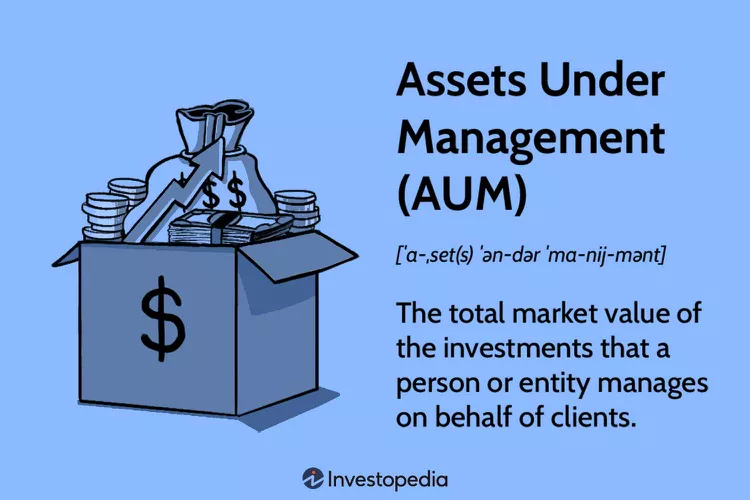What Are Assets Under Management (AUM)?
The amount of money a financial institution manages on behalf of its customers is referred to as its assets under management (AUM).
Key Action items
Resources under administration, known as AUM, allude to how much cash a monetary organization oversees for the benefit of its clients.
A company, mutual fund, or family of funds’ size and strength can be assessed by investors using AUM.
When combined with cash inflows and outflows, we can use AUM as a benchmark to assess market sentiment and money management firms’ health.
In some funds and investment advisory relationships, AUM is used as the basis for compensation and expenses. Definition and Examples of Assets Under Management (AUM) Assets under management (AUM) measure the amount of money or securities that a financial institution manages for its clients. All on account of a common asset, for instance, the asset will include the worth of its property (e.g., stocks, bonds, money) and report that number as its resources under administration.
Banks and other monetary firms report this information each quarter, to some degree since resources under administration will generally vacillate routinely.
Utilizing straightforward, speculative numbers, on the off chance that 10 individuals each put $1,000 in a shared asset, the asset has resources under administration of $10,000. In the event that 10 individuals put $1,000 each in 10 different common assets at a similar firm, the firm has resources under administration of $100,000.
For example, as financial backers put cash into (called “inflows”) or pull out cash from a shared asset (called “surges”), the asset’s resources under administration will increment or reduction. At the point when the worth of a firm or asset’s possessions increments, so do its resources under administration.
Acronym: Assets under management (AUM) are a useful tool for market analysis because they move with the stock market’s currents and are therefore a barometer of investor sentiment.
Note
People and establishments who dissect store execution and inflows and surges of capital can involve AUM as a kind of benchmark of financial backer feeling and conduct.
For instance, eVestment (a part of the organization that works the Nasdaq stock trade) tracks this kind of information. In its exploration it noticed that because of the Coronavirus emergency, mutual funds in April 2020 saw recoveries that were multiple times bigger than some other April since April 2009. This diminished AUM reflects financial backer uneasiness notwithstanding the pandemic.
By observing a huge piece of the billions of dollars put resources into along these lines, we can check the condition of the market.
Steadiness of Monetary Establishment or Counselor
AUM likewise can provide financial backers with a fair of the monetary steadiness of a venture company. Firms with AUM of more than $100 million should enroll with the U.S. Protections and Trade Commission (SEC) and record customary reports, which incorporate their AUM amount.1 These filings assist controllers with directing the monetary establishments that handle our cash.
For example, when you can perceive how a company’s general AUM is spread across different assets, you can more readily comprehend how expanded the asset family is. You can see where the cash supervisor thinks its resources, permitting you to make quite a few suspicions, including what could occur on the off chance that a gigantic surge happened in at least one assets in an enormous asset family.
Note
The Speculation Counselors Demonstration of 1940 illuminates a wide scope of decides that oversee huge monetary organizations and cash the board firms, including AUM detailing requirements.2
Financial backers can involve AUM as one method for estimating the outcome of a resource the board firm. Firms with bigger AUM will generally be more esteemed, with more prominent asset supervisors and guides.
For instance, BlackRock, the biggest resource the executives firm on the planet, had $8.677 trillion in resources under administration as of Dec. 31, 2020.3
Client Resources, Remuneration, and Costs
Resources under administration essentially start as a pool of cash gathered from financial backers. Every financial backer’s singular commitment likewise assumes a major part in seeing a portion of different features related with AUM.
Pay of venture administrators and counselors is reliant upon resources under administration. For instance, multifaceted investments ordinarily work on a “two and twenty” expense structure. They charge 2% of AUM as yearly administration expenses and hold 20% of benefit as a “execution charge” on gains over a certain threshold.4
Monetary counselors likewise frequently charge 0.5%-2% of a client’s resources as their yearly expense.
Common assets additionally charge specific charges and costs in light of complete resources under administration, truth be told some, as 12b-1 expenses are deducted straightforwardly from the all out resources of the asset.
Not all venture items are reasonable for all financial backers, and not all speculation supervisors like to work with clients who don’t have a sizable measure of resources for make due, to some extent due to these expense structures. For instance, a financial backer would have to have somewhere around $10 million in investable resources for have the option to open a record with Goldman Sachs Private Abundance Management.










 Bitcoin
Bitcoin  Ethereum
Ethereum  Tether
Tether  XRP
XRP  Solana
Solana  USDC
USDC  TRON
TRON  Dogecoin
Dogecoin  Lido Staked Ether
Lido Staked Ether